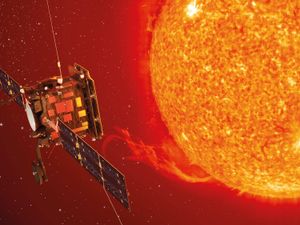Solar Orbiter prepares to capture closest image of the sun ever taken
The UK-built satellite came within 47 million miles of its surface on Monday.

A UK-built satellite observing the sun has made its nearest approach yet, allowing it to take the closest image of our star ever captured.
The European Space Agency’s (ESA) Solar Orbiter came within 47 million miles of its surface on Monday, about half the distance between the sun and Earth.
While Nasa’s Parker Solar Probe, launched in 2018, is able to go further, it does not carry telescopes capable of looking directly at the glowing orb.
In the week after this first perihelion – the point in the orbit closest to the sun – the mission scientists will test the spacecraft’s ten science instruments, including the six telescopes on-board.
Working together, these telescopes should be able to snap the closest photo of the sun ever – though we will not get to see it until mid-July.
“We have never taken pictures of the sun from a closer distance than this,” said Daniel Muller, ESA’s Solar Orbiter project scientist.
“There have been higher resolution close-ups, e.g. taken by the four-metre Daniel K Inouye Solar Telescope in Hawaii earlier this year.
“But from Earth, with the atmosphere between the telescope and the sun, you can only see a small part of the solar spectrum that you can see from space.”
The test is being carried out to prove that Solar Orbiter’s telescopes are up and ready for future scientific observations.
Other instruments will also provide an insight into the environment around the spacecraft, such as the magnetic field and the particles making up the solar wind, which could yield “new and exciting results”.
It comes as Solar Orbiter begins its cruise phase, which will last until November 2021.
After this, it will enter the main science phase, getting as close as 26 million miles to the sun’s surface – beyond that of Mercury, the closest planet to orbit the sun.
“We have a nine-hour download window every day but we are already very far from Earth so the data rate is much lower than it was in the early weeks of the mission when we were still very close to Earth,” Mr Muller continued.
“In the later phases of the mission, it will occasionally take up to several months to download all the data because Solar Orbiter really is a deep space mission.
“Unlike near-Earth missions, we can store a lot of data on board and downlink it when we are closer to home again and the data connection is much better.”
Space Orbiter was constructed by Airbus in Stevenage and blasted off from Nasa’s Cape Canaveral site in Florida on February 10.





